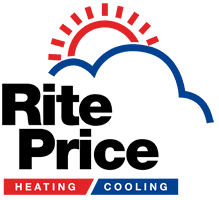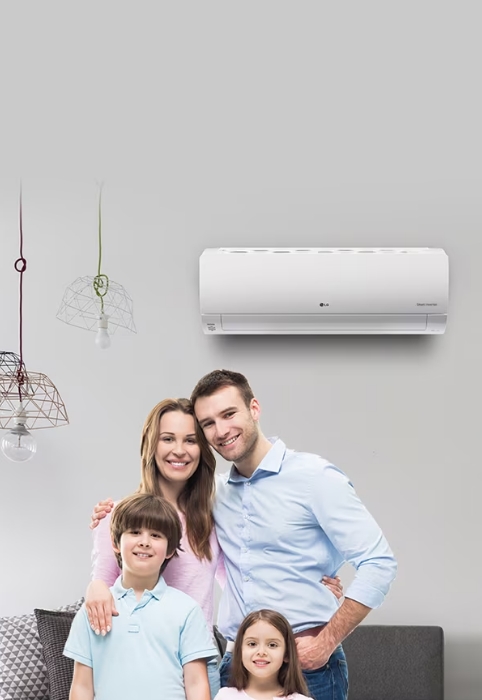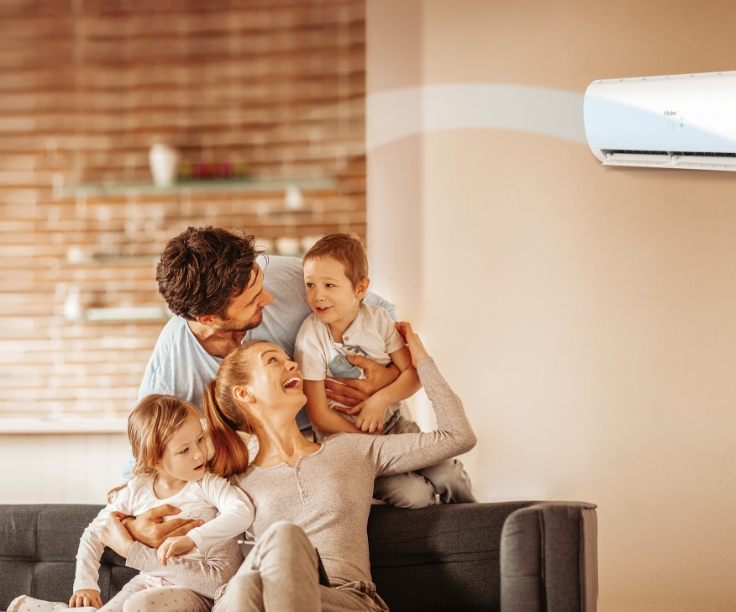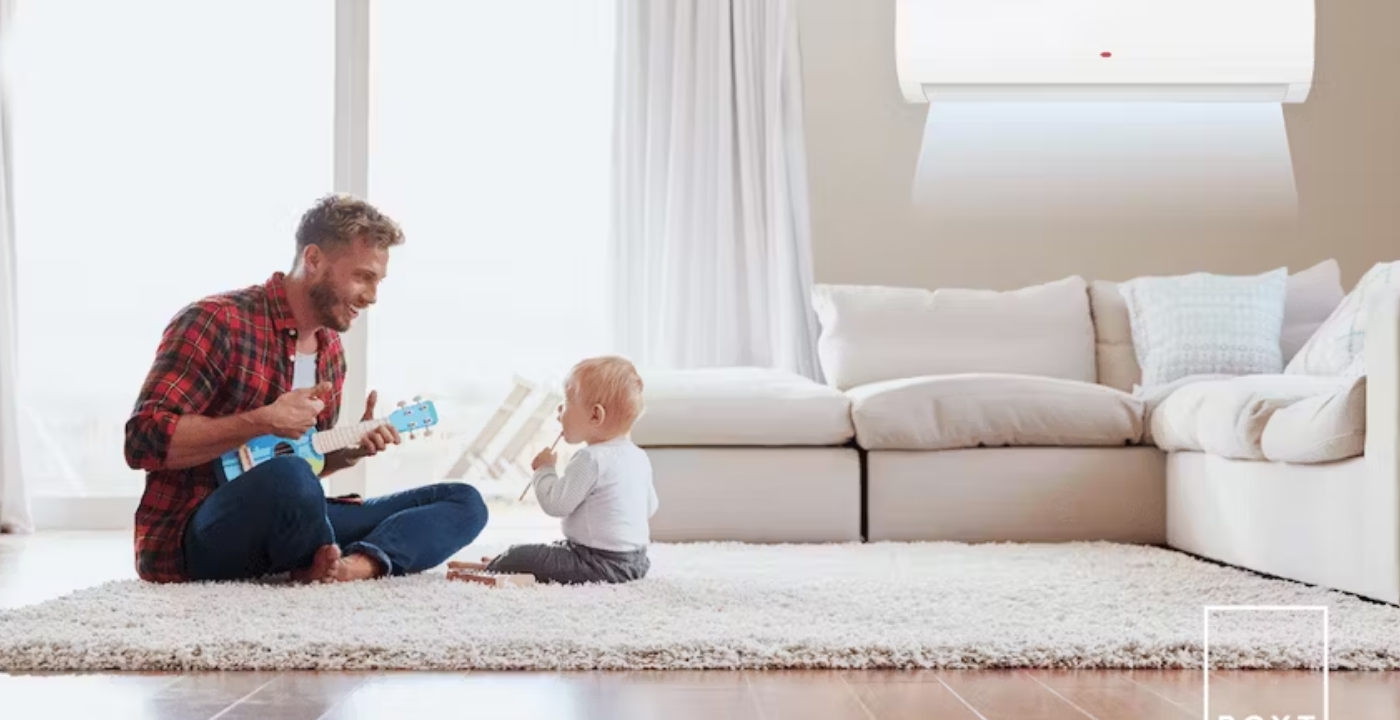Review for split system air conditioners
Split System Air Conditioner Review
Split System Air Conditioners are likely the most common air conditioners you will see in a home. They have been the default air conditioning system used by a majority of homes for decades.
There are many benefits and reasons why home owners choose Split System Air Conditioners.
In this post, we will take an in-depth review into split system air conditioning and it’s unique benefits, and also compare it to other air conditioning types. Such as Ducted Reverse Cycle and Evaporative air conditioners.
While split system air conditioners have many compelling benefits, it is not always the most suited air conditioner for a home.
Split System Air Conditioner – Overview
The Split System Air Conditioner comprise of an outdoor compressor and indoor wall hung units – commonly referred to as fan coils or wall units. The compressor generates the air and conditions it, and the fan units blow the conditioned air into a room or space in the home.
Split system air conditioning require a fan or wall unit to be installed into each room that requires air conditioning. As the wall units are rather obvious and at times, bulky, it is not the most discreet form of air conditioning. As compared to ducted air conditioning for instance.
Below, we will compare split system to other forms of air conditioning.
Split System Air Conditioner – Vs Other Air Conditioner Types
Besides Split System Air Conditioner, there are two other types of air conditioning. Namely, the Ducted Reverse Cycle and Evaporative Air Conditioners. Both types of air conditioners have their unique benefits and are ideally suited to different home layouts and usage models.
Ducted Reverse Cycle Air Conditioners
Ducted Reverse Cycle is a form of central air conditioning. It distributes conditioned air using ducting and vents installed into the roof wall and floor spaces of a home.
Unlike the split system air conditioner, there are no wall units. A ducted reverse cycle air conditioner comprises of an internal and external compressor unit, and a set of ducting and vents that help distribute the air.
The only visible part of ducted air conditioning are the air vents, which are usually unobstrusively installed flush into the ceiling and walls. For this reason, reverse cycle ducted air conditioners are very unobstrusive, and is highly popular with home owners that want a minimalist design to their home.
Like the split system air conditioners, ducted reverse cycle air conditioning is refrigeration-based, which means it cools air using a refrigerant and the process of refrigeration.
Evaporative Air Conditioners
Evaporative air conditioners are similar to ducted reverse cycle air conditioners in that it also uses ducts and air vents to distribute conditioned air. However, that’s where the similarity ends.
Unlike split system and ducted reverse cycle air conditioners, Evaporative air conditioners cool air using the natural process of evaporation. Warm air from a room is passed through damp cooled pads in the unit and blown out like a cool breeze.
It is this evaporative method of cooling that sets evaporative coolers apart from split system and ducted reverse cycles, which uses a refrigerative process.
Evaporative air conditioners produce air that is of a better quality and with a higher moisture content (due to the process of evaporation). While the air from refrigeration-based conditioners (ie. split system & ducted reverse cycle) is cold and crisp, air from an evaporative system feels like a comfortable, gentle breeze. It is easier to breathe and gentler on the skin.
Split System Air Conditioner Review – Features & Benefits
The Split System Air Conditioner has more features than other forms of air conditioning. The use of wall hung fan units actually allows manufacturers to incorporate many unique features into these wall units, which would not be possible with ducted or central air conditioning.
Below is a list of features commonly found in leading brands of split system air conditioners.
Energy Efficiency
Most newer models of split system air conditioning comes with very high energy star ratings. This indicates that they operate with a high level of efficiency.
Energy efficient is first and foremost in the minds of many home owners, because the more efficient the air conditioner is, the lower it’s long term running cost.
In terms of running costs, split system air conditioners and ducted air conditioners are quite similar. Variations are usually due to the differing usage patterns of home owners.
However, the Evaporative air conditioner has the lowest running cost. Due to the fact that it is evaporative-based, and not refrigerative, evaporative air conditioning consumes far less power than split systems or ducted reverse cycle air conditioners.
Inverter Technology
Inverter technology allows the air conditioner to scale it’s power mode up or down, according to cooling or heating requirements of a room.
For example, if the room temperature has achieved the desired or preset level, the inverter kicks in and puts the air conditioner in low power mode. This low power mode consumes far less electricity. Conversely, if more cooling or heating is required, the inverter will scale up the power mode, generating more cold or warm air.
Recent models of both split system and ducted reverse cycle air conditioners come with Inverted technology. Originally invented by Toshiba, Inverted technology significantly increases the operating efficiency of air conditioners. Hence, lowering their power consumption.
All leading air conditioning manufacturers now feature inverter technology in their systems. Mitsubishi Electric, for example, has one of the most effective and efficient implementation of the inverter technology.
Quiet Operation
With recent advances in fan blade and grille designs, split system air conditioners have become very quiet during operation. Even when set to the highest mode, split system air conditioners emit very low levels of noise.
Most home owners do not like to have noisy air conditioners. Hence, all leading brands of air conditioners have invested heavily into producing air conditioners that function almost silently.
Central or ducted air conditioning, since they do not have fan units installed into rooms, are generally quieter in operation than split system air conditioners.
Split System wall units have movable parts (ie. fans) that will naturally generate a higher level of noise emission. However, this is almost unnoticeable to users.
Advanced Air Flow Controls
Since wall units are unique to Split System air conditioning, this feature is not found in ducted reverse cycle or evaporative air conditioning.
Advanced air flow controls have become a prominent feature found in Split System Air Conditioners. Through an advanced control panel, users can configure the air flow pattern of the split system air conditioners, producing a much more effective coverage pattern.
This means that users can “focus” the heating and cooling to certain areas of a room. Significantly increasing the comfort levels of a home.
Aesthetic Design
A few newer models of Split System air conditioners come in sleek and colorful designs. Manufacturers like Samsung, Toshiba and Braemar, feature split system air conditioners in a variety of colours. Matched with very sleek wall units.
These sleek and beautiful wall units can actually add to the interior decor of a room or home. Some home owners leverage these designs wisely to create a elegant look and feel for their homes.
Reverse Cycle Heating & Cooling
Split System air conditioners come with Reverse Cycle function. This means that it can produce both hot and cold air. This is an important feature as it becomes an all-in-one climate control system for a home.
Reverse cycle split system air conditioners can keep your home warm in winter, and cold in summer.
A benefit to having reverse cycle is that it negates the need to install a separate gas heating system for your home. This represents significant cost savings for home owners.
Plasma Filter & Air Purifiers
Multi-layered Plasma filters and built-in air purifiers have also become a much demanding feature in Split System air conditioning. The reason for this is that home owners are becoming more health conscious, and demand better quality air for their homes.
Air conditioning manufacturers like Samsung, Toshiba and Mitsubishi, all have their unique complement of in-built air quality systems.
From multi-layered air filtration, to plasma filters to air ionisers, newer models of split system air conditioners are able to produce better quality air that’s cleaner and healthier to breathe.
These high quality air filtration and purifying systems remove contaminants from the air. Including common allergens, viruses, bacteria and even odours.
Intelligent 3D Sensors
This is another feature that only comes with Split System air conditioners. 3D sensors are installed into the wall units to detect ambient temperatures in a room.
These intelligent sensors determine where the people in a room usually position themselves, and the temperature in that area. If it detects that the temperature is colder than preset level, it will scale down the cooling power. Conversely, if it detects that more cooling is required, it will cause the air conditioner to scale up the cooling power.
This makes for a very comfortable experience as the air conditioner detects and responds according to the climate settings chosen by the user.
Advanced Diagnostics & Self Maintenance
Quite a few models of split system air conditioners come with advanced diagnostics and maintenance features. These allow an air conditioner to provide useful trouble-shooting indicators that help a service technician more efficiently identify any problems.
Trouble-shooting has often been cited as the most time consuming and costly component in the service and repair of air conditioners. Erroneously defining a problem can lead to repeat service calls, unnecessary expenses and prolonged frustrations for home owners.
Brands like Toshiba and Carrier have advanced self diagnostics features that makes repairs much easier.
Many models of split system air conditioners now also come with self cleaning and self maintenance features. The fan grille is constantly cleaned during use to minimise the build up of grime, which clogs up the grilles. These self cleaning features prolong the life cycle of air conditioners and make maintenance much easier.
Wi-Fi Control
All leading brands and models of split system air conditioners also come with advanced WiFi controls. Most manufacturers has downloadable iphone (iOS) and android apps, that allow a user to control almost every aspect of their air conditioning – remotely.
With these apps, users can configure the climate of their homes from anywhere, as long as there is an internet/wifi connection.
From power modes to temperature settings, timer functions and air flow controls, the wifi app allows full control over the air conditioning of a home.
Imagine being able to turn on the air conditioner in your living room 10 minutes before you reach home – on a hot summer day.
Split System Air Conditioner – Suitable For Your Home?
So is split system air conditioner a suitable choice for your home? It really depends on what you are after as a home owner. Some home owners are more concerned about features. Some, are more concerned about power efficiency. Depending on your own usage pattern and key considerations, your air conditioning needs will vary.
Having reviewed the common features of Split System Air Conditioners, let’s now evaluate them against other forms of air conditioners.
Split System Air Conditioner Review – Are They A Good Option?
There are certain scenarios whereby split system air conditioners are a better option than other types of air conditioning. And there are situations when a ducted reverse cycle or evaporative may be more suited.
Below are some considerations that may help you decide if split system air conditioners are ideal for your home.
Home Layout and Air Conditioning
The layout of your home is a key factor in determining the best air conditioning system. Split System Air Conditioners are more suited to smaller, standard homes with 2-3 bedrooms. You could opt for a higher kW split system with larger compressors for more wall units. However, overworking a compressor can decrease its lifespan.
If you have a larger or multi-storey home, installing multiple split systems may be necessary, potentially leading to higher costs. In this case, a ducted air conditioning system may be a more cost-effective solution. Ducted systems use hidden ducts to distribute conditioned air throughout the home, offering a more seamless and less visible setup.
For larger homes, Ducted Reverse Cycle or Evaporative Air Conditioning might be more appropriate. However, for standard-sized homes, a split system is often an easier and more affordable option.
Air Quality Considerations
If air quality is important to your family, split system air conditioners may offer several air quality benefits. They include advanced filtration systems and air ionisers for cleaner, healthier air. For homes with members who have respiratory concerns, like babies or those with asthma, air quality can be a deciding factor.
Evaporative air conditioning provides even more natural, breathable air. It’s gentler on the skin and easier to breathe, especially in dry climates. Split systems, while providing better air filtration, may not match the natural, moist air produced by evaporative cooling systems.
Upfront and Running Costs
When comparing air conditioning systems, it’s crucial to evaluate both upfront and running costs. Split system air conditioners offer a middle ground in terms of pricing. They are usually more affordable to install than ducted air conditioning systems. Thanks to inverter technology, they are also more energy-efficient, which helps lower running costs.
Ducted air conditioning is better suited for larger homes, but its installation costs are typically much higher. The more zones you operate simultaneously, the higher your running costs will be.
Evaporative systems have the lowest running costs. They use natural evaporation, which requires less power compared to refrigerative cooling, making them a cost-effective option for those looking to minimize energy bills.
Split System Air Conditioner Review – Summary
Choosing the right air conditioning system for your home involves several key considerations. Split system air conditioners may be ideal if you have a smaller home or are working with a limited budget.
Consider your budget, the layout of your home, the features you need, and the importance of air quality. For large homes, a ducted system may offer better coverage, while a split system is often easier to install and more cost-effective for smaller spaces.
Ultimately, your home layout, energy efficiency needs, and aesthetic preferences will guide your decision. For homes with a minimalist design, ducted systems might be more appealing due to the absence of bulky wall units.
Need Help with Split System Air Conditioning?
Let Rite Price Heating and Cooling help you make the right decision. As a trusted supplier in South Australia, we provide expert advice and guidance to help you choose the best split system air conditioner for your needs. Send us your house plan, and our consultants will provide tailored advice to ensure your home stays comfortable year-round.
Send in a Quote Request Form today and we’ll be in touch with you shortly: https://ritepriceheatingcooling.com.au/








